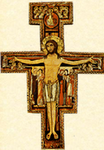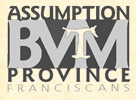Welcome, Pope Benedict XVI! What will he find in the USA?
Our Holy Father, Pope Benedict XVI is expected to make his first papal visit to the United States of America next week, 15 April 2008. With open arms the Catholic Church, young and old, welcomes the Successor to St. Peter and Vicar of Christ to our nation!
Yet, what will he find when he arrives? He is an ardent student of current events and is not ignorant of the reality we face as Catholic Christians here in the USA. You may be aware of the recently released survey from the Pew Forum on Religion and Public Life, called the U.S. Religious Landscape Survey (you can find the results on-line), "The porportion of the U.S. population that identifies itself as Catholic has remained relatively stable in recent decades, but this apparent stability obscures the major changes that are taking place within American Catholicism."
The article continues, "No other major faith in the U.S. has experienced greater net losses over the last few decades as a result of changes in religious affliciation than the Catholic Church. Nearly one-third (31.4%) of U.S. adults say they were raised Catholic. Today, however, only 23.9% of adults say they are affiliated with the Catholic Church, a net loss of 7.5 percentage points. Overall, roughly one-third of those who were raised Catholic have left the church, and approximately one-in-ten American adults are former Catholics."
The survey acknowledges the tide of those who convert to Catholicism -- witness the numbers of adults who are received either as catechumens or as baptized candidates at each year's Easter Vigil. It notes that "The Landscape Survey finds that 2.6% of U.S. adults have switched their affiliation to Catholicism after bein raised in other faiths or in no faith at all."
However, it also notes that ". . . former Catholics outnumber converts to Catholicism by roughly four-to-one . . ." The survey points to the relative steady number of people who identify themselves as Catholics to immigrants -- particularly those from Mexico and other parts of Latin America. Again, "The Landscape Survey finds that nearly half of all immigrants coming to the U.S. (46%) are Catholic, compared with just 21% of the native-born population."
Finally, "The vast majority (82%) of Catholic immigrants to the U.S. were born in Latin America, and most Catholic immigrants from Latin America (52% of all Catholic immigrants to the U.S.) come from just one country -- Mexico." It continues to note that, ". . . Catholics are also represented among immigrants coming to the U.S. from Western Europe, Eastern Europe and East Asia; more than one-in-four of all immigrants form these regions are Catholic."
So, this is part of the reality of the U.S. Catholic Church which our Holy Father is visiting -- those who identify themselves as Catholic and are practicing; those who identify themselves but either practice sporadically or seldom; those who no longer identify themselves as Catholic and have left altogether; and the growing immigrant Catholic populations from Latin America, East Asia and Europe.




